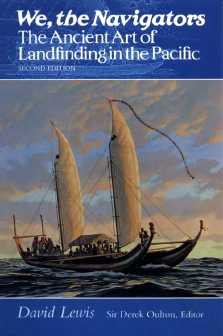|
We, the navigators :
the ancient art of landfinding in the Pacific / David Lewis ;
ed. by sir Derek Oulton. - Honolulu : University of Hawai'i
press, 1994. - XXI-442 p. : ill., maps ;
23 cm.
ISBN 0-8248-1582-3
|
PAUL
ADAM :
Le remarquable livre de David Lewis met un point final à
l'essentiel des discussions qui durent depuis longtemps sur
l'habileté, ou la chance, des navigateurs
polynésiens et
micronésiens quand ils devaient trouver leur route en haute
mer.
David
Lewis n'a, à proprement parler, rien découvert
d'important qui n'ait été
déjà connu. Mais,
par une enquête détaillée, il a
retrouvé des
marins polynésiens et micronésiens qui, non
seulement
avaient conservé en mémoire une partie de
l'héritage ancestral, mais encore savaient toujours les
mettre
en pratique. Il a donc avec eux expérimenté,
testé
et précisé les méthodes
anciennes : le
résultat est aussi concluant que favorable.
(…)
→ Note
de lecture (de la première édition — Canberra, 1972), in Revue française
d'histoire d'outre-mer, 1973 | Vol. 60 | 218 | pp. 138-139 [en ligne]
|
|
NOTE
DE L'ÉDITEUR :
This new edition includes a discussion of theories about traditional
methods of navigation developed during recent decades, the story of the
renaissance of star navigation throughout the Pacific, and material
about navigation systems in Indonesia, Siberia, and the Indian Ocean.
|
FRANCIS
COWAN 1 : [David Lewis] a
payé de sa personne pour connaître l'art de la
navigation à l'ancienne, voyageant sur des barques
primitives commandées par des indigènes, et a
parcouru en observateur éclairé la
Polynésie de l'Ouest et la Micronésie, sans
compter ses observations dans l'archipel indonésien,
à Manus et en Nouvelle-Zélande, sans oublier non
plus ses études auprès des Eskimos de l'Alaska et
des Chukchi de Sibérie.
☐ Société
des Études Océaniennes, Bulletin, 275,
septembre 1997
|
| CONTENTS |
Foreword
to the first edition, by S.H. Riesenberg
Acknowledgments
PART ONE, The Puzzle
1
Rediscovery of a vanishing art
2
Piecing the mosaic
PART TWO, Directing the craft
3
Voyaging canoes
4
Steering by the stars
5
Keeping course by sun, swells, and wind
PART THREE, Orientation on the
empty ocean
6
Dead reckoning
7
Orientation concepts in dead reckoning
PART FOUR, Expanding one's
target and position fixing
8
Island blocks, birds, and clouds
9
Swell patterns and phosphorescence
10
Expanded target landfall in practice
11
Position fixing at sea
PART FIVE, The lonely seaways
12
Reasons for voyaging
13
The renaissance of far voyaging
14
The long seaways of Eastern Polynesia
Appendix
I Variations of star bearings with latitude, by V.
Radhakrishnan
Appendix II Directional marks ashore
Appendix III Table of tahitian star pillars and islands
Notes,
Glossary, Locations of the main islands on other places, References,
Index
|
|
| COMPLÉMENT
BIBLIOGRAPHIQUE |
- « We,
the navigator : the ancient art of landfinding in the
Pacific », Honolulu : University press of
Hawai'i, 1972 ; Canberra : ANU press, 1972
|
- Ben Lowings, « The Dolphin : the life of David Lewis », [s.l.] : Lodestar books, 2020
|
|
|
| mise-à-jour : 24 janvier 2022 |

|
|
|
|